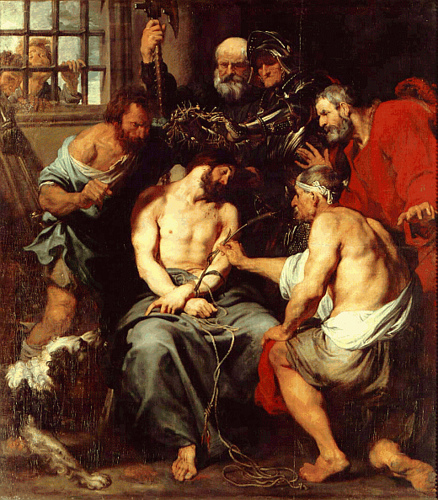 Here is an offering for Good Friday.
Here is an offering for Good Friday. Van Dyck painted this in 1620. It has all the classic baroque elements that reflect the Catholic worldview as discussed in previously in regard to, for example,
Procaccini's Scourging of Christ.
Consider it in the context of the difference between portrait and sacred art as discussed in another earlier article,
here. Van Dyck is one of the greatest portrait artists ever, yet he is careful not paint any of these figures as portraits. In a portrait, the face is the most important aspect. Yet here, each face is either in profile or shadow. The psychological aspects are transmitted through gesture rather than dramatic or exaggerated facial expression. Notice how, for example, he directs our thoughts towards the person of Christ by putting his face in shadow. It is not that he wants us to ignore Our Lord's face, but rather, given our natural tendency always to focus more on the face of the person, if it is downplayed relative to the rest, it results in a more balanced appreciation of whole person and the general human characteristics with which we can identify.

If you want to learn first hand more about the baroque style, the one authentic naturalistic artistic tradition of the Church, then we run a
summer program at Thomas More College of Liberal Arts in Merrimack, NH. You can spend two works learning by doing and learn the traditional academic method of the Old Masters - a systematic way of drawing that in two weeks will raise your drawing skills above those of any conventional modern mainstream art school in the country. The teacher is internationally known portrait painter
Henry Wingate. A skilled teacher, Henry takes you from the level you are at. So this is suitable for experienced or inexperienced artists.
If you're not an artist, but want to know more about this anyway, come to the weekend course, at Thomas More College, which takes place in the first weekend of August. We have called it
Traditional Paths to Creativity and Inspiration because it teaches all the things that artists need to know aside from their skills and so would be good for art lovers, or people wishing to enhance their creativity in whatever their work or passion happens to be.
As a meditation, here is a passage from the Office of Readings of Tuesday of Holy Week that struck a chord with me. The words are by St Basil and taken from the book On the Holy Spirit:
When mankind was estranged from him by disobedience, God our Saviour made a plan for raising us from our fall and restoring us to friendship with himself. According to this plan Christ came in the flesh, he showed us the gospel way of life, he suffered, died on the cross, was buried and rose from the dead. He did this so that we could be saved by imitation of him, and recover our original status as sons of God by adoption.
 Here is an offering for Good Friday. Van Dyck painted this in 1620. It has all the classic baroque elements that reflect the Catholic worldview as discussed in previously in regard to, for example, Procaccini's Scourging of Christ.
Here is an offering for Good Friday. Van Dyck painted this in 1620. It has all the classic baroque elements that reflect the Catholic worldview as discussed in previously in regard to, for example, Procaccini's Scourging of Christ. Here is an offering for Good Friday. Van Dyck painted this in 1620. It has all the classic baroque elements that reflect the Catholic worldview as discussed in previously in regard to, for example, Procaccini's Scourging of Christ.
Here is an offering for Good Friday. Van Dyck painted this in 1620. It has all the classic baroque elements that reflect the Catholic worldview as discussed in previously in regard to, for example, Procaccini's Scourging of Christ.